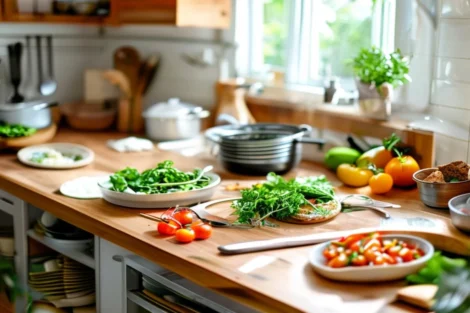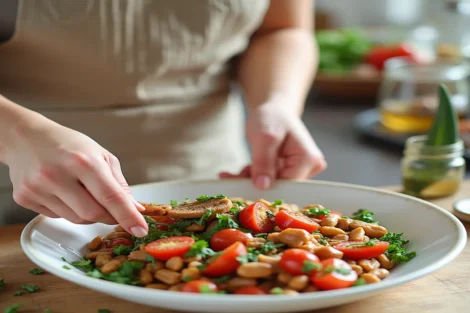Preparing meals at home can be a rewarding and enjoyable experience that brings families and individuals closer together. Whether you are a seasoned cook or just starting, there are numerous ways to contribute to meal preparation. The question, “What do you do to help prepare meals at home?”, invites a variety of responses, as every person’s contribution can make a big difference in the overall process.
Table of Contents
1. Planning the Menu
One of the most important aspects of meal preparation is planning what to cook.
- Weekly Menu: Planning a menu for the week helps save time and money. It ensures that ingredients are on hand and avoids last-minute stress.
- Involving Everyone: Family members can contribute by suggesting their favorite dishes or trying new recipes.
- Dietary Needs: Taking note of any dietary restrictions or preferences ensures that meals are inclusive and enjoyable for all.
2. Grocery Shopping
Helping with grocery shopping is a significant way to contribute to meal preparation at home.
- Making a List: Creating a shopping list based on the planned menu prevents unnecessary purchases.
- Choosing Fresh Ingredients: Picking fresh fruits, vegetables, and proteins ensures high-quality meals.
- Budgeting: Shopping within a budget helps control expenses and encourages smarter choices.
3. Prepping Ingredients
One of the most time-consuming parts of cooking is prepping ingredients. Helping with this step can make the process much faster.
- Chopping Vegetables: Cutting vegetables in advance saves time during cooking.
- Marinating Proteins: Marinating meats or tofu the night before enhances flavor.
- Measuring Ingredients: Pre-measuring spices, oils, and other components ensures efficiency while cooking.
4. Cooking Together
Cooking as a team is a great way to bond and learn new skills.
- Following Instructions: Reading and following a recipe is an easy way to help.
- Assisting the Cook: Stirring sauces, setting timers, or flipping pancakes are simple yet helpful tasks.
- Trying New Techniques: Learning new cooking methods, like grilling or baking, adds variety to meals.
5. Setting the Table
Preparing meals at home isn’t just about cooking; setting the table plays a significant role in creating a welcoming atmosphere.
- Arranging Utensils: Placing forks, knives, and spoons neatly adds to the dining experience.
- Adding Decor: Simple touches like flowers or candles can make mealtime special.
- Serving Drinks: Pouring water, juice, or wine ensures everyone is ready to enjoy the meal.
6. Cleaning as You Go
Keeping the kitchen clean during meal preparation is an essential but often overlooked contribution.
- Washing Dishes: Cleaning utensils, cutting boards, and pots as they are used keeps the workspace tidy.
- Wiping Surfaces: Regularly wiping counters prevents clutter and mess.
- Organizing Leftovers: Packing up extras for future meals ensures nothing goes to waste.
7. Serving the Meal
Once the meal is ready, serving it to family members or guests is a rewarding part of the process.
- Plating the Food: Presenting food attractively enhances the dining experience.
- Portion Control: Ensuring balanced portions prevents overeating and reduces waste.
- Explaining the Dish: Sharing details about the recipe or ingredients adds a personal touch.
8. Exploring New Recipes
Experimenting with new recipes is an exciting way to help prepare meals at home.
- Cultural Dishes: Trying cuisines from around the world broadens culinary horizons.
- Healthier Alternatives: Modifying recipes to include healthier ingredients promotes wellness.
- Seasonal Ingredients: Incorporating seasonal produce keeps meals fresh and sustainable.
9. Teaching and Learning
Preparing meals at home is an excellent opportunity for teaching and learning.
- Teaching Kids: Introducing children to cooking builds lifelong skills and encourages healthy eating habits.
- Learning Together: Taking a cooking class as a family or watching online tutorials can be a fun group activity.
- Sharing Knowledge: Passing down family recipes preserves traditions and strengthens connections.
10. Enjoying the Meal Together
The culmination of all efforts in preparing meals is enjoying them together.
- Family Time: Sitting down to eat as a family fosters communication and togetherness.
- Appreciation: Expressing gratitude for everyone’s contributions makes the experience fulfilling.
- Leftover Creativity: Turning leftovers into new dishes the next day ensures that nothing goes to waste.

11. Organizing the Kitchen
A well-organized kitchen is the backbone of efficient meal preparation.
- Decluttering: Regularly sorting through pantry items ensures that expired goods are discarded and essential items are easily accessible.
- Labeling Containers: Using labeled jars for spices, grains, and other staples makes finding ingredients simple.
- Creating Work Zones: Designating specific areas for chopping, cooking, and plating streamlines the process.
12. Preparing Healthy Snacks
Meal preparation isn’t limited to main dishes—preparing snacks can be equally important.
- Fruit and Veggie Trays: Washing and cutting produce in advance encourages healthy snacking.
- Homemade Granola Bars: Mixing oats, nuts, and honey makes for a nutritious, on-the-go option.
- Energy Bites: Combining dates, cocoa powder, and peanut butter creates a quick, no-bake treat.
13. Meal Prepping for the Week
Batch cooking and meal prepping are lifesavers for busy schedules.
- Cooking in Bulk: Preparing large quantities of soups, stews, or casseroles and storing them in portions saves time during the week.
- Freezing Meals: Freezer-friendly dishes like lasagna or chili are perfect for quick reheating.
- Breakfast Prep: Overnight oats, smoothie packs, or egg muffins ensure that the day starts with a healthy meal.
14. Adding Personal Touches to Meals
Personalizing meals can elevate the dining experience.
- Customizing Flavors: Adjusting spices and herbs to suit personal preferences adds depth to dishes.
- Creating Sauces: Homemade sauces like pesto, marinara, or gravy add a unique touch.
- Plating Artistry: Arranging food attractively makes meals feel special and more enjoyable.
15. Taking Responsibility for Specific Meals
Taking charge of certain meals can lighten the workload for others.
- Breakfast Champion: Preparing smoothies, pancakes, or omelets starts everyone’s day off right.
- Lunch Specialist: Packing sandwiches, salads, or wraps ensures that lunch is delicious and nutritious.
- Dinner Planner: Handling dinner, from menu planning to cooking, can bring the family together at the end of the day.
16. Cleaning Up After Meals
Cleaning up is just as important as cooking and a significant way to contribute.
- Dishwashing: Washing dishes or loading the dishwasher prevents a pile-up of dirty utensils.
- Sweeping and Mopping: Keeping the kitchen floor clean reduces the risk of slips and messes.
- Recycling and Composting: Sorting waste responsibly supports sustainability efforts.
17. Involving Technology
Leveraging technology can make meal preparation easier and more enjoyable.
- Using Recipe Apps: Apps like Yummly or Tasty provide endless meal ideas with step-by-step instructions.
- Smart Gadgets: Slow cookers, air fryers, and instant pots simplify complex recipes.
- Voice Assistants: Devices like Alexa or Google Assistant can set timers, read recipes aloud, or convert measurements.
18. Hosting Themed Cooking Nights
Transform meal preparation into a fun event by hosting themed cooking nights.
- Italian Night: Make homemade pasta, pizza, or tiramisu together.
- Mexican Fiesta: Prepare tacos, enchiladas, and churros as a family.
- Asian Cuisine: Try your hand at sushi rolling, stir-frying, or dumpling making.
19. Learning from Mistakes
Every cook, beginner or experienced, faces occasional challenges in the kitchen.
- Burnt Dishes: Use the experience as a learning moment to adjust cooking times or temperatures.
- Improvised Recipes: Experimenting with substitutes when ingredients are missing can lead to creative new dishes.
- Feedback: Asking for honest opinions from those who eat the meal helps improve future efforts.
20. Sharing Meal Prep Duties Equally
Distributing tasks ensures that everyone feels involved and valued.
- Task Assignments: Dividing responsibilities like chopping, stirring, or setting the table makes the workload manageable.
- Rotating Roles: Switching duties regularly keeps things fair and interesting.
- Encouraging Participation: Inviting everyone to help, even in small ways, fosters teamwork.
The Benefits of Helping Prepare Meals at Home
Helping to prepare meals at home isn’t just about food—it offers numerous personal and family benefits:
- Skill Development: Cooking enhances creativity, problem-solving, and time management skills.
- Healthier Eating: Home-cooked meals are often more nutritious than takeout or processed foods.
- Stronger Relationships: Working together in the kitchen strengthens bonds and creates lasting memories.
- Cultural Appreciation: Exploring recipes from different cuisines broadens culinary knowledge and appreciation for other cultures.

21. Creating a Calm Cooking Environment
A well-organized and pleasant environment can make meal preparation more enjoyable.
- Decluttering the Workspace: Ensuring that countertops are clear before starting helps maintain focus.
- Playing Music: Soft background music can make the cooking process relaxing.
- Lighting and Ventilation: Good lighting and fresh air create a comfortable atmosphere for cooking.
22. Developing a Meal Prep Schedule
Sticking to a schedule can make meal preparation more efficient.
- Setting a Regular Time: Preparing meals at consistent times helps develop a routine.
- Allocating Roles: Assigning specific tasks to family members or roommates saves time.
- Meal Timing: Planning cooking times ensures that dishes are ready to serve simultaneously.
23. Getting Creative with Leftovers
Helping to reduce food waste by transforming leftovers is an excellent contribution.
- Reinventing Dishes: Leftover roasted chicken can be turned into chicken salad or tacos.
- Freezing for Later: Packing leftovers into freezer-friendly portions makes future meals easy.
- Creating Soups or Stir-Fries: Adding leftover vegetables and proteins into soups or stir-fries creates a quick, hearty dish.
24. Assisting with Dietary Adjustments
Catering to specific dietary needs is an important way to help at home.
- Allergen Awareness: Ensuring meals are free from allergens when needed is crucial.
- Customizing Recipes: Substituting ingredients like gluten-free flour or plant-based milk supports dietary preferences.
- Portion Control: Helping to measure portions can contribute to balanced eating habits.
25. Experimenting with New Cooking Techniques
Introducing new techniques can elevate meals and inspire creativity in the kitchen.
- Sous Vide Cooking: Using precise temperature control for tender, flavorful dishes.
- Fermentation: Preparing homemade pickles, yogurt, or kimchi adds unique flavors to meals.
- Grilling Indoors: Using a grill pan to replicate outdoor grilling flavors when weather doesn’t permit.
26. Supporting Family Traditions
Helping to prepare traditional dishes can preserve cultural and familial connections.
- Learning Recipes from Elders: Spending time with grandparents or parents to learn their recipes.
- Cooking for Special Occasions: Preparing family favorites during holidays or celebrations.
- Passing Down Recipes: Writing down and sharing family recipes with younger generations.
27. Managing Meal Presentation
Presentation can make meals more appealing and enjoyable.
- Plating Techniques: Learning to arrange food attractively on plates enhances the dining experience.
- Garnishing: Adding fresh herbs, a drizzle of sauce, or a sprinkle of cheese for visual appeal.
- Serving Style: Opting for buffet-style serving or individual plating depending on the occasion.
28. Organizing Food Storage
Proper storage keeps ingredients fresh and reduces waste.
- Using Airtight Containers: Storing perishables in sealed containers prolongs their shelf life.
- Labeling Leftovers: Adding dates and labels to stored food ensures nothing is forgotten.
- Rotating Stock: Placing older items at the front of the pantry or fridge encourages their use.
29. Supporting Sustainable Practices
Helping prepare meals at home can also involve eco-friendly habits.
- Using Seasonal Ingredients: Buying in-season produce supports local farmers and reduces environmental impact.
- Composting Scraps: Turning vegetable peelings and other scraps into compost for gardening.
- Minimizing Plastic Use: Opting for reusable bags and containers during shopping and storage.
30. Engaging with Family or Friends
Meal preparation can be a social activity that brings people together.
- Cooking with Kids: Teaching children basic cooking skills and involving them in simple tasks.
- Hosting Cooking Nights: Inviting friends or family to prepare meals together and share culinary knowledge.
- Sharing Responsibilities: Rotating cooking duties among household members ensures fairness and variety.
The Lasting Impact of Meals at Home
The process of preparing and sharing meals at home goes beyond nourishment—it builds a sense of community, responsibility, and joy. Whether it’s a casual weekday dinner or a festive holiday feast, every contribution matters in making mealtime special.
Strengthening Family Bonds
One of the most profound benefits of meals at home is the opportunity to strengthen relationships. Cooking together encourages teamwork, communication, and the passing down of family traditions. Children who participate in meal preparation develop lifelong skills and a deeper appreciation for home-cooked food.
Fostering Healthier Eating Habits
Home-cooked meals allow for better control over ingredients and portion sizes, ensuring a balanced diet. By incorporating fresh vegetables, lean proteins, and whole grains, meals at home can contribute to a healthier lifestyle. Additionally, experimenting with new recipes helps to diversify nutrient intake and keeps mealtime exciting.
Encouraging Creativity in the Kitchen
Preparing meals at home is an excellent opportunity to get creative. Whether it’s trying new cuisines, modifying traditional recipes, or plating dishes artistically, the kitchen becomes a space for innovation. Experimenting with herbs, spices, and cooking techniques can lead to delicious discoveries.
Saving Money and Reducing Waste
Eating at home is often more cost-effective than dining out or ordering takeout. Planning meals ahead of time and shopping with a list help minimize impulse purchases and food waste. Leftovers can be repurposed into new dishes, reducing the need for additional groceries and supporting sustainable practices.
Creating Meaningful Memories
The simple act of preparing and enjoying meals at home creates lasting memories. Whether it’s laughter over a cooking mishap or the joy of tasting a perfectly seasoned dish, these moments contribute to the warmth and comfort of home life. Hosting themed cooking nights or family recipe swaps can make mealtime even more engaging.
Embracing the Joy of Meals at Home
In conclusion, actively participating in meal preparation enhances not just the quality of food but also the overall dining experience. The time spent in the kitchen, from chopping ingredients to savoring the final bite, fosters a sense of fulfillment and togetherness. By prioritizing meals at home, individuals and families can cultivate healthier habits, save money, and most importantly, create cherished moments that last a lifetime.
The Personal Rewards of Helping Prepare Meals at Home
Contributing to meal preparation offers several personal benefits:
- Skill Building: Learning new techniques and recipes enhances your cooking repertoire.
- Confidence: Successfully preparing meals boosts self-esteem and independence.
- Health Awareness: Being involved in cooking encourages mindfulness about ingredients and portion sizes.
Conclusion: Meals at Home
When considering the question, “What do you do to help prepare meals at home?”, the possibilities are endless. From the initial stages of planning and shopping to the final touches of plating and cleaning, every step is valuable. By actively participating, you contribute not only to delicious meals but also to a positive, collaborative household atmosphere.
Meal preparation is more than a task; it’s an opportunity to connect, learn, and create. Whether you’re an experienced chef or a beginner in the kitchen, your efforts make a difference. So, grab an apron, find your role, and enjoy the journey of preparing meals at home.

